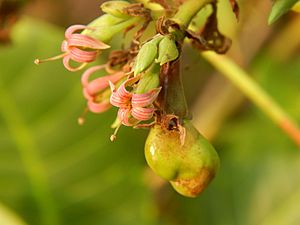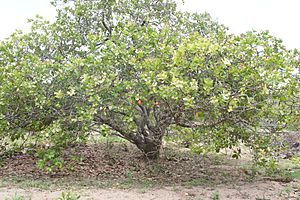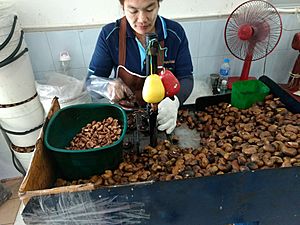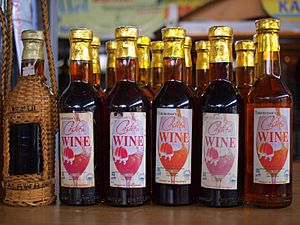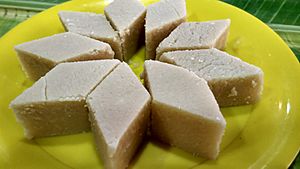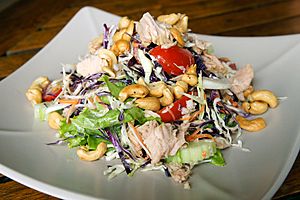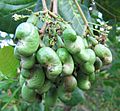Cashew facts for kids
Quick facts for kids Cashew |
|
|---|---|
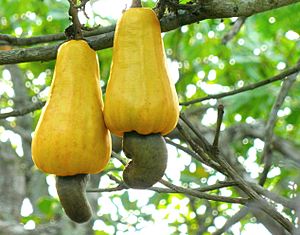 |
|
| Ripe cashew fruit | |
| Scientific classification | |
| Kingdom: | |
| (unranked): | |
| (unranked): | |
| (unranked): | |
| Order: | |
| Family: | |
| Genus: |
Anacardium
|
| Species: |
A. occidentale
|
| Binomial name | |
| Anacardium occidentale |
|
The cashew tree (Anacardium occidentale) is a tropical tree that stays green all year. It gives us the tasty cashew seed (which we often call a nut) and the cashew apple.
Cashew trees originally came from northeast Brazil. Between 1560 and 1565, people from Portugal brought them to Goa, India. From there, cashew trees spread across Southeast Asia and then to Africa. Today, many cashews are grown in countries like Vietnam, Nigeria, India, and Ivory Coast.
In 2013, the world produced about 4.4 million metric tons of cashews (still in their shells). Vietnam was the biggest producer that year. By 2014, Ivory Coast became the top African country for growing and exporting cashews.
Contents
What Does a Cashew Tree Look Like?
The cashew tree is a big, evergreen tree. It can grow up to 14 meters (about 46 feet) tall. Its trunk is often short and has an interesting, irregular shape.
The biggest cashew tree in the world is in Natal, Rio Grande do Norte, Brazil. It covers an area of about 7,500 square meters (over 80,000 square feet)! There's also a smaller type called the dwarf cashew. It grows up to 6 meters (about 20 feet) tall. This smaller tree is often more profitable because it grows faster and produces more cashews.
The Cashew Apple and Nut
What most people think of as the cashew fruit is actually an "accessory fruit." This means it's not the true fruit. It's an oval or pear-shaped part called the cashew apple. When it's ripe, it turns yellow or red and is about 5 to 11 centimeters (2 to 4 inches) long. The cashew apple is edible and has a strong, sweet smell and taste.
The real fruit of the cashew tree is a kidney-shaped drupe. This small, hard fruit grows at the end of the cashew apple. Inside this drupe is a single seed, which is the cashew "nut" we eat.
The cashew seed has a double shell. This shell contains a special liquid that can irritate your skin. It's similar to the liquid found in poison ivy. Because of this, cashews are usually not sold in their shells. Some people are allergic to cashews, though it's less common than allergies to peanuts or other tree nuts.
How Do We Use Cashews?
The cashew nut is very popular and used in many ways. People eat them as a snack, add them to recipes, or make them into cashew cheese or cashew butter.
The cashew apple is a light reddish to yellow fruit. Its juicy inside can be made into a sweet fruit drink. It can also be distilled into an alcoholic drink.
Cashews in Cooking
Cashew nuts are used in snacks and cooking, much like other tree nuts. They are very common in Indian cuisine and Pakistani cuisine. You can find whole cashews used to decorate sweets or curries. They are also ground into a paste to make sauces for curries. Sometimes, cashews are powdered and used in Indian sweets and desserts.
The cashew apple's pulp is very juicy. However, its skin is delicate, which makes it hard to transport without damage. In Latin America, people make a refreshing fruit drink from the cashew apple pulp. It has a tropical flavor, sometimes described as tasting like mango, green pepper, and a hint of grapefruit.
In recent years, more cashew trees have been grown in African countries. This is to meet the demand for making cashew milk. Cashew milk is a popular plant-based alternative to dairy milk. The cashew fruit juice and pulp are also used to make sweets, juices, alcoholic drinks, and even flour or cheese.
Other Uses for Cashews
Cashew oil is a dark yellow oil. It's pressed from cashew nuts (often from broken pieces). This oil can be used for cooking or as a salad dressing.
Cashew nutshell liquid (CNSL) is a natural, yellowish liquid. It's a byproduct from processing cashew nuts. This liquid is used to make many things, including medicines, antioxidants, and materials that fight fungus. It's also used in traditional medicine and to protect wood from termites.
Even cashew nuts that are not good enough for people to eat can be used. They, along with the leftover parts from oil extraction, can be fed to farm animals. Animals can also eat the leaves from cashew trees.
Cashew Allergies: What You Should Know
For a small number of people (about 6%), eating cashews can cause serious allergic reactions. These reactions can even be life-threatening. The allergies are caused by proteins found in tree nuts. Cooking cashews usually does not remove or change these proteins.
Allergic reactions to cashews can also happen if tiny bits of nuts are accidentally mixed into other foods. This can occur during food processing, handling, or manufacturing.
About 1.8 million Americans have an allergy to tree nuts. Young children are most often affected, and these allergies often last a person's whole life. Some parts of the world have more people with cashew allergies than others.
Images for kids
-
Distilling cashew apple liquor (muchekele) in Mozambique
See also
 In Spanish: Merey para niños
In Spanish: Merey para niños


